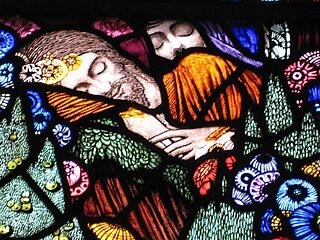Friday Links
January 10, 2025
The Agony in the Garden, designed by Harry Clarke
A Deep Dive Into Contemporary Catholic Poetry with Ryan Wilson
The Lough Derg Podcast with Lanta Davis
Jeffrey Reimer: Images of the Invisible God
Jon Sweeney on Catechist Nicholas Black Elk in the Aftermath of the European Invasion
Thomist Poets Reading Series with Paige Parker
S. P. Cooper on King Arthur’s Youth: Growing Up in the Once and Future King
A Deep Dive Into Contemporary Catholic Poetry with Ryan Wilson
Ryan Wilson joins Tod Worner to discuss his new poetry anthology with April Lindner, Contemporary Catholic Poetry “and poetry’s magnificent wake-up call.” In his introduction to the book, Wilson writes:
One of the things human beings are always forgetting is that the world is greater than any individual’s idea of it. The world is more complex, more manifold, more mysterious than any mortal mind can fully comprehend, as is the human individual.
The Lough Derg Podcast with Lanta Davis
Lough Derg (also called Station Island and St. Patrick’s Purgatory) is a holy island in Ireland, a place of pilgrimage since the Middle Ages. Marcas Ó Conghaile Muirthemme, Director of Pastoral Programmes at lough Derg, speaks with scholar Lanta Davis about the role that art and literature play a role in our spirituality. In discussing Harry Clarke’s stained glass windows on Station Island, particularly the one of the Blessed Mother holding the dead Christ in her womb, she says:
…when we say yes to life, we say yes to to pain, to suffering to death…grief is weed to gratitude.
Jeffrey Reimer: Images of the Invisible God
Gazing in devotion at an icon involves this double movement—a glance, a disorientation, a second finding. The face in an icon demands that the viewer enter into its world on its terms; and its terms are submission, suffering, holiness. One must find oneself addressed. One must first be mastered by the image before one can enter into it—before, as Jean-Luc Marion says, “the gaze of man is lost in the invisible gaze that visibly envisages him.” When we look at the face of Christ in an icon, we are looking at the face of a man, but not only a man. The gaze of faith sees the face of God.
Jon Sweeney on Catechist Nicholas Black Elk in the Aftermath of the European Invasion
Black robes were perceived as having more in common with the Oglala than their Protestant counterparts—not because Episcopal missionaries wore white robes instead of black ones but because the ritual and practices of Catholicism seemed closer to those of Native medicine men. Many of the Jesuit priests who served at Pine Ridge Reservation, starting with the teachers invited by Red Cloud, to the Oglala resembled a wicasa wakan, or “holy man.” Jesuits have been living and ministering in Pine Ridge Reservation ever since Red Cloud invited them to start that first school. It was also Jesuits who helped complete the first Bible translation into Lakota, in 1885, picking up on work begun several decades earlier by French fur traders.
Thomist Poets Reading Series with Paige Parker
In the next reading for the Thomist Poets Reading series, the lovely Paige Parker will read her poems on January 19. You won’t want to miss this as Paige is a wonderful poet who renders the reality of God’s love for us in her verse. You can sign up at the link. I hope to see you there.
S. P. Cooper on King Arthur’s Youth: Growing Up in the Once and Future King
The story of King Arthur has been, at least in its outlines, familiar to most readers of English literature for the better part of a milennium. Although he is the son of King Uther, Arthur grows up in the household of Sir Ector. After Uther’s death, Arthur’s destiny is revealed when he draws a sword from a stone (or anvil), establishing his right to rule England as King. Bewitched by his half-sister, he unwittingly sleeps with her, conceiving a child who is both nephew and son: Mordred, who will be partly to blame for the downfall of Camelot. The rest of that blame rests upon Arthur’s best knight, Launcelot, and his Queen, Guinevere. Their ongoing affair provides Mordred the opportunity to drive a wedge into the Arthurian court, dividing Arthur’s Round Table knights against themselves, and bringing the realm to ruin.


